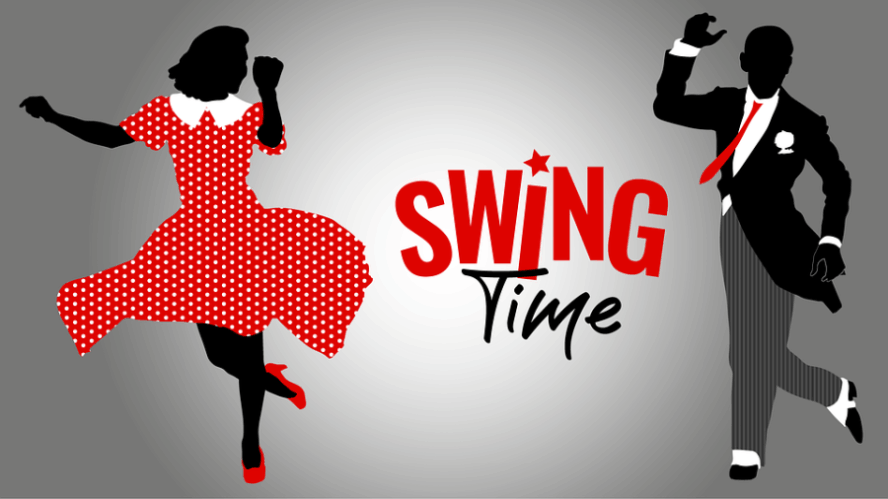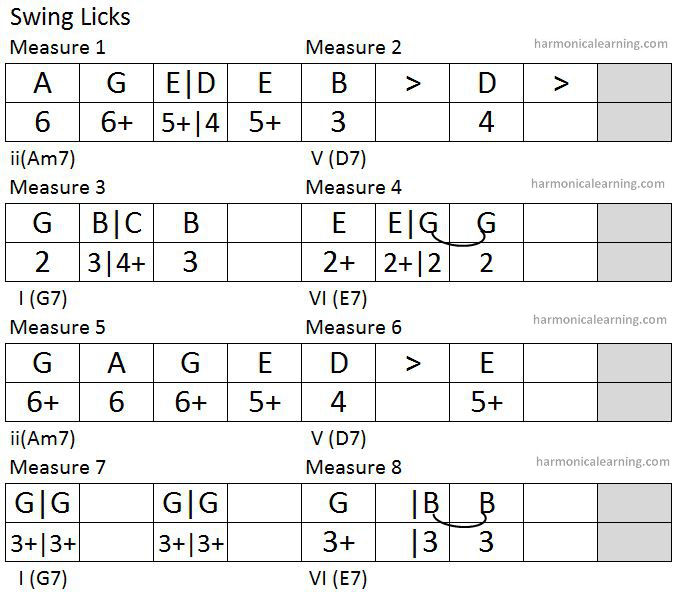This interactive beginner harmonica lesson is about the swing. We will learn several licks and practise them with the metronome, then we are going to combine these licks to perform a whole swing chorus on the backing track. The lesson is supported by tabs containing the notes and the harmonica holes that should be used when playing.
You'll need a C harmonica for this lesson.

Jazz, but also rock and pop music can literally sweep listeners along, causing them to tap their feet involuntarily or move their heads in time with the rhythm. However, to this day musicians still find it hard to say what swing actually is; you can certainly feel it, but you just can't explain it.
One big thing that characterizes the swing music is about rhythm: rather than sounding successive eighth notes for the same length of time, the first is held longer than the second (the swing note). The swing ratio, i.e., the duration ratio of these two notes, is often close to 2:1, and it has been found that it tends to get shorter at higher tempos and longer at lower tempos.
Concerning the chords and the scales used in the swing, like in jazz music in general, we can often make use of major scales, pentatonic scales, as well as several minor scales. In addition, very often some chromatic passages are inserted while moving from a target note to another. In this regard, taking a diatonic harmonica to play jazz music could appear inappropriate; let’s say that if you can play harp in different position, then you can work quite well on jazz tunes, taking advantage of the use of the bending technique, as well, if you can, of the overfbows playing.
For this particular lesson, since it has been designed for beginner harmonica players, we are going to use just the notes of the pentatonic scale, in particular the G pentatonic scale, considering that we are playing in second position, using a C harp on a G backing track. You will notice that even if using few notes, we can perform swing harmonica in a pretty much nice way, without using bent notes. For this purpose, I designed this lesson licks working on the central part of the instrument, where all the needed notes are present.
Now it is time to play! Let’s learn the first swing harmonica lick, but first we want to analyze the simple chord progression I used for this lesson: It is called ‘ii-V-I’, and it is a very common progression used by jazzists when trained about improvisation. This particular chord sequence, similar to the blue one, makes use of the dominant seventh chord that resolves on the first degree. Our brain expects this ‘cadence’. In our swing chorus, this happens twice: G7 resolves to C, while E7 resolves to A.

In lick one, we start playing the hole 6 draw, note A. This note is the root note of the first chord, A minor seventh. Playing the root note of a chord is a very safe way to perform. Notice that in these first two measures we play all the pentatonic scale notes. G, A, B, D and E.
In measure 2, we play both B and D, third and fifth degrees of the G scale, as well of the G chord. As you can see, we keep being in line with the harmony!

In the second lick we work pretty much around the G chord notes in measure 3, then in measure 4, the harmony goes on a dominant seventh chord E7. How stated before, this chord resolves to the A chord. Notice that we are playing a G natural note over a chord where the G is supposed to be sharp! It works, in music there are some particular cases in which minor and major thirds can be played in the same context. If you play the blues, the most of the time you have dominant seventh chord progressions where you play the ‘blue note’ that is a minor third, but also the major third.

The third lick starts on G, hole 6 blow. G is the minor 7th of the A minor seventh chord. Once again we support the harmonic progression.

In the last lick we just underline the progression key, G, playing this note, as well as the third B.

Here is the full swing chorus that we are going to practise:

In the following video you can practise alone on the backing track:
As you have experienced yourself, learning using the ‘listen and repeat’ approach is really valuable and funny. The use of the audio and visual metronome helps you to keep the tempo and makes you to acquire the right skills to perform later on the backing tracks or with a band.
I’m pretty sure you enjoied learning with me and I hope to see you soon in a more complete harmonicalearning.com course, like the ‘ Diatonic harmonica beginner course’. Keep harpin’ !
Want to learn more about our courses? Click on the following image to get to our online harmonica school.
If you want to comment this lesson use the contact form available here.
John Mayer
Thanks man, great tutorial. Swing music put in this way sounds easier! I learned how to play these exercises in a few days, and I really like the video lessons and how you build them with tabs. I'm going to wait for the coming lessons!
Francisco Quinn
This is the First of your lessons I followed. I always loved swing music, been playing about a year now, although I've had my harmonica for 10 years or so. Really cool jam videos to get practising. I'll visit these pages often now!
Robert Schaeffer
Great methodology! The exercises are clear and the videos make the practising funny and effective. After playing for a year, I realize that some simple riffs like these are what I should have been working more on, and just practicing to make them sound better and better. Thank you for this.